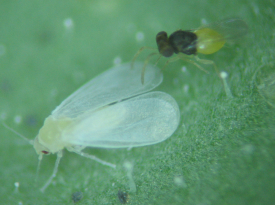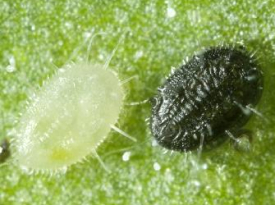- Track your orders
- Save your details for express checkout



Shopping
Aphid Control
| Pest Species | Control Agent |
|---|---|
| Green peach aphid - Myzus persicae | Use our product Aphidius to combat these pests. |
| Melon aphid - Aphis gossypii | The Dusky Ladybird can be used in combination with Aphidius, and provides added defense against psyllids |
Description
Aphids are soft-bodied insects with a globular appearance, long thin legs and antennae. A pair of projections (cornicles) emerge from the rear end of the body. Adult length varies between 1-2 mm, and both winged and wingless forms occur. When present, there are two pairs of thin transparent wings.
Body colour varies between yellow to pale green and dark green. Colour varies between species, and depending on the time of year and host plants on which they feed.
Nymphs are greenish or yellow and resemble small adults without wings.
Eggs, when they are laid, are elliptical in shape, pale yellow or green when first laid and then turn black.
Differentiation between aphid species requires expert advice.

Distribution and host range
Both green peach aphid and melon aphid occur throughout the world and New Zealand. Both greenhouse and outdoor crops can become infested by these species.
Both species attack a wide range of crop plants and weed species. Some strains of melon aphid show preferences for host plants, and lack the ability to adapt to other hosts. Different strains may also display different reproductive strategies.

The pest: whitefly (left) & the solution: Encarsia (right)

Normal whitefly pupa (white) and parasitized pupa (black). An adult Encarsia will emerge from the black scale(right)
Signs and symptoms
Aphids feed using piercing-sucking mouth parts that are used to penetrate the sap stream of plants. Both adults and nymphs cause damage. However, the direct feeding by aphids is normally regarded to be of minor importance unless very high numbers of aphid are present on a crop.
The principal cause of damage by green peach aphid and melon aphid is through the transmission of plant virus diseases.
Aphids generally prefer feeding on the young, soft leaves, stems and buds, where they form colonies.
Signs and symptoms of aphids include
-
Colonies of aphids clustered on young stems, leaves and buds
-
Wilting and distortion of leaves and young shoots
-
Yellowing and premature death of leaves and young plants
-
Honeydew on leaves and fruit, with black sooty mould fungus
-
Symptoms of virus disease (which vary with crop plant and type of virus)
It is important to seek early professional advice if you suspect the virus disease is present in your crop.
Life history and habits
Aphids have complex life cycles which are governed by environmental and host plant conditions.
In colder climates, many aphid species produce sexual forms in autumn that mate and lay eggs on woody host plants (the primary host), and emerge as winged forms in spring that migrate to colonise crop plants.
In warmer climates, aphids reproduce asexually all year round on a large range of secondary hosts such as potato, tomato, brassica crops and weeds including sow thistle and dock.
On greenhouse and outdoor crops aphids reproduce asexually (without mating) and produce many generations per year. Each female is capable of producing 50-60 off spring over a 20 day period under ideal conditions. Female aphids give birth to first instar nymphs rather than lay eggs, and all offspring are female. The nymphs and adults are wingless in summer generations.
There are 4-5 nymph stages depending on the species, host plant and temperature and each stage takes about 2 days to develop. A complete generation can take as little as 10-12 days at temperatures between 21-27 C. The lower temperature threshold for development for some species is a low as 5 C.
As aphid densities increase or the quality of the host plant declines winged forms are produced, and these winged aphids disperse to new hosts. The main dispersal periods for aphids are spring and autumn.
Both adults and nymphs cause feeding damage and transmit virus diseases. Winged aphids pose the greatest threat for the dispersal of virus diseases.
Economic impact
The most significant impact from aphids comes from the transmission of plant virus diseases.
Green peach aphid is known to transmit alfalfa mosaic, potato leafroll, tomato yellow top, beet western yellows, cucumber mosaic, lettuce mosaic, potato virus Y, water melon mosaic virus 2 and zucchini yellow mosaic viruses.
Melon aphid is known to transmit over 50 plant viruses including water melon mosaic virus and zucchini yellow mosaic virus.
Direct feeding by aphids is less significant unless very high numbers are present on young plants.
Honeydew may be a problem on some crops. Melon aphid tends to produce more honeydew than green peach aphid.
Contamination by aphids on some crop produce may present a quarantine or market access risk.
Pest management
Control of aphids is the main approach to the control of plant virus diseases. Rapid action is often needed to avoid the establishment and spread of virus disease in a crop.
Monitoring
Plants should be visually inspected for the signs of aphid infestation. Look for the signs of aphid colonies under the young leaves or along the stems, and for any signs of honeydew or cast 'skins', or distorted young foliage growth.
Flag or note the positions of infested plants, and direct early control methods to those locations.
Different aphid species may colonise different parts of the plant. For example, green peach aphid tends to cluster on the young shoots whereas melon aphid is usually more evenly spaced along the stem.
Yellow sticky traps or cards can be used to monitor the invasion of winged aphids into a crop. Sticky traps should be used in conjunction with crop inspection to determine when control actions are required.
Because aphids reproduce extremely rapidly under ideal conditions in a greenhouse and have the potential to spread virus disease, very low levels of aphids are tolerated on many crops.
Non-chemical methods
A number of practices are recommended to prevent or minimise the establishment of aphids and virus diseases on greenhouse crops. These include:
-
Use virus free seed or transplants
-
Remove virus-infected plants from the crop
-
Eliminate weeds or volunteer crop plants that may harbour aphids and viruses
-
Use virus-resistant cultivars
-
Use screens to minimise the entry of aphids into a greenhouse
Biological control
A variety of natural enemies (predators, parasites and diseases) has been researched to assist with the management of aphids. The parasite (parasitoid), Aphidius colemani and the predator Aphidoletes aphidimyza are the most commonly used biological control agents for these pests.
Aphidius colemani is available from BioForce Ltd, who sells the product Aphidius.
Aphidoletes aphidimyza is available from BioForce Ltd, who sells the product Aphidoletes (currently unavailable)
Orius vicinus is available from BioForce Ltd, who sells the product Orius.
Both Aphidius colemani, Aphidoletes aphidimyza and Orius vicinus are most effective when they are used in an Integrated Pest Management programme, when the use of harmful pesticides is avoided and effective crop management practices are adopted.
Chemical control
A range of insecticides is claimed to be effective against aphids, although few have specific registration claims for use on greenhouse crops.
Monitor crops to ensure insecticides are applied only when necessary. Adults and nymphs are controlled readily by insecticides at the recommended label rates when using effective application techniques.
Resistance is known in New Zealand populations of green peach aphid and melon aphid. If poor control is experienced with one insecticide, use an insecticide from a different chemical group. Select insecticides on the basis of previous knowledge of resistance patterns.
Apply sprays to crops in a manner to ensure good coverage of the undersides of leaves. Crops recently de-leafed allow better spray penetration. Spot spray 'hot spot' areas to minimise the spread and build of aphids in a crop.
Care should be taken to consider the effect of insecticides on beneficial insects or mites that may be being used in integrated pest management programmes. Consult with BioForce Ltd before applying any insecticide when beneficial insects or mites are being used.
If you are uncertain about the identity of any pest in your crop, or need advice on the management of pests contact BioForce Ltd, office@bioforce.net.nz.